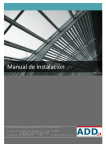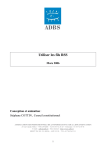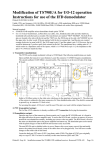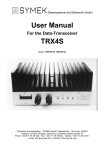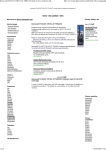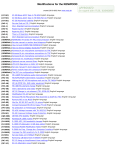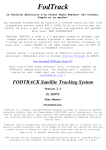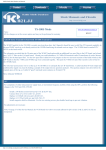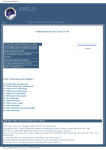Download KB2LJJ Radio Mods Database
Transcript
KB2LJJ Radio Mods Database KB2LJJ Radio Mods Database ® Radio Mods Database and Manuals Modifications for the Kenwood TS-790 TS-790 mods.for G3RUH/TAPR-PSK www.r6-ru4montesecchieta.it TS-790A for use with the paccomm MC-NB96 G3RUH TS-790 & 9600 Baud Operation (Rev 2) UO-14 RX frequency tracking for TS-790/FT-736 TS-790 cross band repeater mod TS-790 with serial frequency control TS790E - Burned out diode 800MHz Receive Mod for Kenwood TS-790 TS-790 SSB Power Increase TS-790 A/E 9600bd via ACC4 port RX-problem Kenwood TS790 ALC-modification Convert TS790E to the USA TS790K and RX/TX mod TS790 SSB Power Up FM 455Khz ceramic filter choice In todays FM transceivers you will find either the CFU (4 element) or the CFW(6 element) type 455Khz ceramic filter for FM. The CFU is mechanical smaller. The CFW, which is used in the TS790, has better frequency characteristics. The choice of filter type depends on what bandwidth you prefer. Some commonly used sub versions: Type BW CFx455B 30 Khz CFx455C 25 Khz CFx455D 20 Khz http://www.kb2ljj.com/data/kenwood/ts-790.htm (1 di 19)01/09/2009 0.13.16 IZ5CCV KB2LJJ Radio Mods Database CFx455E 15 Khz CFx455F 12 Khz CFx455G 9 Khz The TS790 uses a CFW455F in each IF strip for FM. Competition, like Icom (746 and 910) use two selectable FM filters(FM narrow and wide); F and G type, but using the 4 element version (CFU). I have tested both Icoms extensively on the FM narrow/wide effects and found the following: 1. Lowering interference; despite the low stopband specs, the better selectivity of the narow 9Khz filter do help avoiding "next channel interference" 2. Better sensitivity; smaller BW creates better S/N ratio at weak signal levels. 3. Restricted IF BW results in slightly less audio bandwidth. How much 'usable evidence' did I find during the above tests ? 1. QSO was possible yes/no. In most occasions the next-channel (12.5Khz) interference completely dissappeared. Rigs having no filter choice and having the "E" version filter (older or i.e. IC821, IC271) as such suffer more from interference. 2. QSO was possible yes/no 3. I'm not into Hifi. But the narrow BW does have a negative side effect: stations which are overmodulating (= more swing) will appear outside the filter, causing audible drop-outs. Next, if you require wider BW for 9K6 packet use etc, the 20 or even 30Khz filters are to be preferred. See also the mods info on several websites. '73 Mark, PA5MW TS-790 mods.for G3RUH/TAPR-PSK This short note is addressed to Paul DU1POL originaly, but it may be help of them who has the same problem,I uploaded addressed To: All here. Hello Paul G3RUH 9.6kbps modem connection need mod. to both TX and RX. of 790. TX..... connect new 1kohm R to the point D81 and R358(1k ohm) OR connect to CONNECTOR-31 directly. RX..... IC8(MC3357P)---for main RX, IC1(MC3357P)---for sub RX pin #9 is the point to draw RX signal. Usualy, sub RX is used for satellite communication as TX/RX freq. is different. But I drew both main and sub signal and switch them with a microrelay.This relay can be controled with main panel SW 144ATT.(see 790 manual). These mods. are essential for G3RUH 9.6kbps, but also usable for FO-20 PSK. BUT.....with my experience, there is many trouble to use this mods. for TAPR PSK modem. TX audio level setting, RX noise (MC3357P pin#9 has 455khz wave element).....and so on. http://www.kb2ljj.com/data/kenwood/ts-790.htm (2 di 19)01/09/2009 0.13.16 KB2LJJ Radio Mods Database So, I use ACC2 for TAPR PSK modem (also usable for 1200AFSK) ACC2 connection 4---GND 9---PTT 11---TXD audio signal in 1 --3.3k--3 --3.3k---/ connect together to RX audio. two small 1/8w 3.3k regitor mixes main and sub audio, so it is able to use for cross band full duplex and mono band half duplex operation. These registor can be mounted in ACC2 13 pin plug. UP/DWN control from TAPR PSK modem to 790 U12 and JP5/6 setting U12 pin 8 pin 5 ------G --- D E B 790 mic terminal ------ UP pin 4 ------ DWN pin 3 ------ GND line pin 6 and pin 7 must be jumpered and connect to ground. ● ● ● R75 2.7kohm may be changed to 300-500ohm for steady photo couple. C32, C34 (10uF) must be changed to 3.3uF or 4.7uF for rapid doppler shift tracking. R7 in TX audio output circuit must be changed to 2.2Kohm as the original have heavy phase distortion. With this change, TX audio connection to mic (or ACC2) is no problem (no need dirct varactor feeding). Mods. to audio drop problem in 790 computer control. In computer control from rear ACC1 terminal,frequency setting command makes 10m sec.of audio drop(mute),and data collapse occur in PACKET operation. This problem is fixed by killing the blanking pulse to IF amp circuit. remove Q4(2SC2712) on IF unit and short the collector circuit to GND (R15 470 ohm). This mods. is essential for auto freq. control with KCT/Tuner for low orbit Packet satellite. This is all of my mods. to 790/G3RUH/TAPR-PSK modem Best regards. Sueo Asato JA6FTL http://www.kb2ljj.com/data/kenwood/ts-790.htm (3 di 19)01/09/2009 0.13.16 KB2LJJ Radio Mods Database TS-790A for use with the paccomm MC-NB96 G3RUH The Kenwood TS-790A makes a wonderful 9600 BPS Packet Radio Transceiver as it has an excellent front end, powerful transmitter, and 144,440, and 1.2 GHZ coverage. The CFW-455F filter inside is not too narrow despite what you may have read and coupled with the low noise front end of the rig enables the G3RUH modem to reliably decode valid data that barely moves the S-meter. The modification discribed below is simple, reversible, and does not impair normal operation or the appearance of the transceiver. This is a "no holes" modification as it allows the G3RUH modem to be connected to ACC 4 jack on the rear panel. Place the TS-790A upside down on a soft clean surface so as not to mar the cabinet. Remove the bottom cover to expose the IF. Board. With the front panel facing you the work area is the upper left quarter of the IF board. Identify pin 9 of IC8 (MC3357P). There are two of these chips on the IF board but only the main demodulator IC is in the work area. RX audio to the modem will be derived from this point. Next locate J31 a two pin connector near D81 and X2 (10.965 OSC). TX audio from the modem will be supplied to the hot lead on J31. Note the large aluminum heat sink that spans across the IF board near the rear of the chassis. A round lug will be mounted on it near the rear of ACC 4 jack. Wire an eight pin din plug. Use shielded cable for TX and RX audio. No traces on the IF board need to be cut. Pins 3 and 5 of ACC 4 are not connected to anything as the radio comes from the factory. Make sure the Din plug fits the jack properly before wiring it. PIN PIN PIN PIN 2 3 5 8 - ground TX audio from G3RUH RX audio to G3RUH PTT Prepare two six inch lenghts of RG-174. Prepare one end of each cable so that the shield will reach the ground lug mounted on the large aluminum heat sink. The cables will be routed over the top of the heat sink and will not be crushed when the bottom cover is reinstalled as there is adequate clearance. Solder the center conductor of one cable to pin 3 on the rear of ACC 4 (verify with ohm meter). Solder the center conductor of the other cable to pin 5 on the rear of ACC4 (verify with ohm meter). Dress the cable connected to ACC 4 pin 5 over to IC8 pin 9. Cut to size and solder (be careful- use minimum heat and thin solder). The exposed shield is discarded and heat shrink tubing placed over the end to prevent any shorts that would otherwise occur from having exposed strands of the shield touching something. Dress the other cable connected to pin 3 of ACC 4 to J31 and cut to size. Prepare the end in the same manner as the other cable. Solder the center conductor to pin 2 of J31. This is accomplished by cutting the lead going to pin 2 about 1/2 inch back, stripping the insulation back 1/8 inch on the two ends, and then joining the center conductor of the cable going to pin 3 of ACC 4 and soldering the three exposed ends together. Use heat shrink tubing to cover the solder joint. NOTE that the banded end of D81 is not the cathode of the varactor diode ! There is no need to insert any additional capacitance in series with J31 pin 2. The shields are not connected at both ends of the RG-174 cables in order to prevent ground loops. The Aluminum heat sink was used as ground as no other ground was available that was close to ACC 4. Your sight may be better than mind and you may find one. Adjust VR-1 on the MC-NB96 board for 75 mv p-p as measured on pin 2 of J31. This will give a good initial setting for injected transmit audio level. This completes the modification. 9600 BPS Packet can now be enjoyed on each of the bands installed in your TS-790A. For non-packet operation either unplug the modem from ACC 4 or turn off power to the modem. For 9600 packet operation unplug the mic and turn the mic gain to minimum. Thanks to Frank Anderson, W7ZTA and Jeff Angus, WA6FWI for their help. Please report any errors or suggestions to: Mike Hooper KF6PU @ WB6YMH.#SOCA http://www.kb2ljj.com/data/kenwood/ts-790.htm (4 di 19)01/09/2009 0.13.16 KB2LJJ Radio Mods Database TS-790 & 9600 Baud Operation (Rev 2) These notes were partly taken from James Miller, G3RUH notification for FT736R and the article of my good friend Sueo Asato, JA6FTL. These mods are working very well with 9600 bps UO-14 and CBBS operation currently used at my site. Please refer to G3RUH's notification for FT736R for more detail. RX/TX mod suitablity remains same as his notes. TS-790 ; FM Direct from Discriminator Detected and amplified/buffered FM direct from the receiver discriminator is available from Pin-9 IC1 (Sub) or IC8 (Main). I use IC1 (Sub) for reception. TS-790 ; Direct varactor FM Modulation Inject your TX audio at the cathode side of diode D81 with a 1K ohm register in series. You can find D81 near Q73 in your IF UNIT diagram. Misc It takes a bit hard work for very small and jungle PCB. Use tiny tools. Carefully adjust the TX audio level by VR1 of the modem, it's rather low. You would probablly need some local friend to do this adjustment, asking him to tell you his TNC's DCD LED stays steady (no flicker). UO-14 RX frequency tracking for TS-790/FT-736 The doppler shift range in overhead pass reaches to 20kHz. It is essential to tune-in RX frequency for good through put. I assembled auto freq. tracking for UO-14 FSK signal reception and achieved good result. [Block diagram] RX discri.out<-- voltage comparater--INV--NOR--switching TR---> Down control (Q1) (Q2) (Q2) (Q3) | G3RUH board DCD ----------------------[Circuit connection table.] GND Q1:LM324 or TL084 Q2:74HC02 Q3:2SC945 etc. | (C:0.01) | -------------*a<-(R:1M)--------3 Q1 1----6 Q2 4----3 Q2 1---(R:470)---B Q3 C---> DWN *c +12V--(R:8k)--- 2 | -5 | -2 | -E | | ---| ----| ---| ---| | | | (VR:10K) GND | GND | | GND | GND +12V +5V *b<-- G3RUH board DCD line-----------Q1 11 4 Q2 7 14 *a: to RX discri out (=G3RUH board RX IN) *b: to G3RUH board DCD line (U10 pin 13) *c: to down control pin of mic terminal (TS-790 mic pin 3) http://www.kb2ljj.com/data/kenwood/ts-790.htm (5 di 19)01/09/2009 0.13.16 KB2LJJ Radio Mods Database setting of VR:10k The discriminator IC output level is 5.8V+-2V. Without RX signal, set the VR to Q1 pin 1 level turn HIGH->LOW. In my case, I assembled the circuit on a small universal PCB and enclosed into TINY-2 with NB96 board. In the case of FT-736, DL signal polarity is different from TS-790 so change as follow -----3 Q2 1------|>------> DL signal to mic terminal 2 | Diode (1S1588 etc) ----- TS-790 cross band repeater mod To operate the TS790A in the repeater cross band mode, diode D32 on the control board must be opened. In addition, two resistors must be soldered to a 13 pin din plug which will be connected to the ACC. 2 jack on the back panel of the transceiver. To locate and open D32 1. Disconnect the power supply and antenna from the radio. 2. Remove the 14 screws that secure the top and bottom covers. 3. Carefully remove the top and bottom covers. 4. Locate the control board. this is a vertically mounehind the front panel. 5. Locate diode d32 towards the top right side of the board. 6. Using a small pair of wire cutters,cut the lead of the diode. do not pull on the lead or the diode as this may tear the foil on the other side of the board. 7. assemble the radio by reversing steps 1-3. 13 pin DIN plug configuration. 1. Using a small flat blade screwdriver, lift up on the tab of the nylon cover. 2. Once the tab clears the slot of the metal holder, pull the cover off the plug. 3. Carefully separate the two metal holders and remove the pin assembly. 4. First tin pins 1,8 and 11 of the assembly so the resistors can easily be soldered in place. http://www.kb2ljj.com/data/kenwood/ts-790.htm (6 di 19)01/09/2009 0.13.16 KB2LJJ Radio Mods Database 5. SOLDER A 100K ohm,1/4 watt resistor between pins be cut and shaped before soldering). 6. Solder a 1.5K ohm,1/4 watt resistor between pin 8 and the lead of the 100K ohm resistor that is attached to pin 11.(the resistor leads should be cut and shaped before soldering) 7. Wrap a small piece of electrical tape around the resistors. This will insulate them from the metal holder after the plug is assembled. 8. Mount the pin assembly in the two metal holders. 9. Slide the cover over the plug until the tab engages in the slot. The "U" shaped strain relief will not be used. 10. Plug the 13 pin din plug in the ACC2 jack on the back panel of the radio. Operating procedures The repeater cross band operation allows the TS790A to receive on one bag signals will automatically be switched to the sub band.The TS790A will then re-transmit the signals from the main band. Each band may contain offset and sub-audible tone information (an optional TSU-5 must be installed in EACH BAND for decode). 1. Press the MAIN function swich to select the MAIN band. 2. Select the first operating frequency and mode (fm only). Select the offset as required. 3. If the CH.Q is on,press the CH.Q switch to turn the function off. 4. Select the sub-audible tone as required. 5. Transfer the contents of the MAIN band to the SUB band. 6. Select the second operating frequency anf mode (FM ONLY) and turn the CH.Q off. 7. Select the offset and sub-audible tone as required. 8. Adjustd point. The TS790A will transmit in the repeater crossband mode if the squelch controls are set too low or a signal is received. 9. Adjust the power control to allow normal output power from the MAIN band. 10. Adjust the sub band volume control to a normal listening level to monitor incoming signals. 11. To place the radio in the repeater cross-band mode,press the F. switch and then press the M.IN switch. An asterisk will light in the MAIN band display for confirmation. 12. To cancel the operation,repeat step 11 and disconnect the DIN plug. http://www.kb2ljj.com/data/kenwood/ts-790.htm (7 di 19)01/09/2009 0.13.16 KB2LJJ Radio Mods Database 13. If the DIN plug is left in place after use,bleedover from the SUB band audio if present will be mixed with any transmitted audio. This will make your audio during TSU-5 TONE UNIT When the TSU-5 tone units are not installed,only the tone (encode) function can be used. If CTCSS is to be used it must be installed in both bands to function with the cross-band repeater mode. TX audio adjustment The audio gain can be adjusted by variable resistor VR36 on the IF unit. If the range of VR36 does not suffice for normal transmit audio, the values of the resistors on the 13 pin din plug can be changed. As an example, if the audio is too low, reduce the value of the 100K ohm resistor and increase the value of the 1.5K ohm resistor. To access VR36 1. Remove the bottom cover of the radio to expose the IF unit. 2. locate VR36 3. Use a plastic alignment tool to adjust VR36 for the bottom cover. TS-790 with serial frequency control by Kohjin Yamada, JR1EDE This note is the summary of our discussion made among W9FMW, JA6FTL and myself. The first report has been brought by WB0KSL expressing TS-790 has audio drops at the frequency change command in it's serial control. JA6FTL confirmed the data loss at the product detecter on his scope too. These are as terrible as if we use KCT Tuner in it's serial control option. Kenwood replied to my inquiry "It is made as so to prevent the noise of PLL, about 100m sec mute is created". Kenwood suggests the modification as below but it should be made on user's responsibility. This should be solved in their next products, I strongly told them. JA6FTL and I confirmed that it now works perfectly on FO-20's actual test and uSATs too with the following modification. Kenwood suggestion;(Refer to IF DIAGRAM) You could disable the mute function by following methods, both or item 2 only. 1. Delete D20 or R191 (for SUB audio) As far as you would use the rear data port (ACC2), it's *NOT* necessary to do this, although you would still have the audio drop at the sound of loud speaker. Of cource, you should do this modification when you would hook up the audio data from Microphone Plug. 2. Put a jumper between Q4 collector and emitter (for SUB RF Block) This modification is a *MUST*. You can do this by several ways but the above is most easy. The following discussion might help you a bit; (partly eddited by me) I wrote to W9FMW; >Cut the line between Q4 Collector and R15 (470 orhm) and Ground the end of >R15. JA6FTL made the mod removing Q4 entirelly and grounding the end of R15. >Q4 located the left of Q5, they are located roughly oposite side of L2, L3. >JA6FTL says the modification needs a magnifying glass, Hi. http://www.kb2ljj.com/data/kenwood/ts-790.htm (8 di 19)01/09/2009 0.13.16 KB2LJJ Radio Mods Database There is 1 Reply. Here is additional info. to the modification. Yes..... Need magnifying glass (I am not farsighted nor shortsighted Hi.) This modification is to disable the blocking line for IF amp. Audio muting function remains unchanged, but it is no problem to use rear data port. (Audio muting circuit consists of D20 and Q12) 1. Put the frontside toward you and remove the bottom cover of 790. 2. Remove the 13 screws that fix IF board. Lift over up the board toward you. 3. Q5 and Q4 are located just opposite side of L2 and L3. Chip Q5(printed "V11") has 4 solderd legs, and it's located next to R15 (470 ohm surface mount resistor, printed as "471"). Q4 is located just beside R15 and has 3 legs. TS790E - Burned out diode Hi to all fellow TS-790E owners, Just a quick note to warn users of this magnificent wireless of the dangers of exceeding the recommended duty-cycle on full power transmit on 430MHz. My 790 puts out about 45 watts of RF on UHF (slightly more than the quoted spec). The other night whilst listing messages from the BBS, I suddenly lost RF output from the UHF section. The radio was also drawing excessive current when the TX was keyed (22 Amps @ 13.8V - normally 16 Amps @ full output power). I returned it the following day to the dealer where I bought it 22 months ago and they diagnosed a burnt out RX/TX switching diode (D2 in the circuit diagram). It was not only burnt out, it had disappeared! It is a special component and cost about 15 - total repair cost 50. One week later I got it back and all was well again with no other damage apparent. I do not think the failure was caused by using packet as the duty-cycle at the time was very low indeed (just listing the new messages for the day). I think it all started the night before when I had an hour long QSO using full power FM on 433.550. The radio gets pretty hot under these conditions and its internal cooling fan was running continuously after about 5 mins on air. The manual does warn the user to allow the transmitter to cool after extended transmitting, but is not specific about the duty-cycle when using full power. So, please be careful with your 790 and don't cook it like I did. It is NOT CAPABLE OF A 100% DUTY CYCLE when using maximum power on UHF. It does not get as hot when using VHF but caution should be exercised if the fan is running continuously. I would not expect there to be any problems when using SSB on either band, nor would I expect normal packet/data use to cause problems. 800MHz Recieve Mod for Kenwood TS-790 http://www.kb2ljj.com/data/kenwood/ts-790.htm (9 di 19)01/09/2009 0.13.16 KB2LJJ Radio Mods Database Author: Schreiter Keith - [email protected] Cut D29 on the control unit. Install a BNC connector on the rear panel where the black plastic plug is. Run a piece of 50 ohm coax from the BNC to TP201/202 on the RF unit. TP 201 is the center and 202 is the shield. That is the 800 MHz rx antenna. Subject: Photos http://www.kb2ljj.com/data/kenwood/ts-790.htm (10 di 19)01/09/2009 0.13.16 KB2LJJ Radio Mods Database http://www.kb2ljj.com/data/kenwood/ts-790.htm (11 di 19)01/09/2009 0.13.16 KB2LJJ Radio Mods Database TS-790 SSB Power Increase Author: Greg - [email protected] If you look at the specs on your new TS-790, you will notice that the SSB power output is about 10W lower than FM or CW. This is an easy fix. On the IF board, on the bottom of the radio, near the MIC/RF POWER knobs, there is a small jumper/diode labeled "SSB PWR DOWN". It is cut from the factory. Reconnect it. On the schematic, it is shown as a jumper but it looks like a diode. There was enough metal left on the leads on mine to reconnect it. The PEP power will now be the same as FM/CW. The PA for both 432 and 2m on this radio are rated at 60W so it shouldn't be a problem. I havn't tried to raise the power up to 50W yet as my Commander likes about 45W+ if it is carefully tuned for around 1100W+ out. With these PA's, 50W should be quite safe on both bands. This mod should have no affect on 1296 as it is rated the same on SSB and FM. I will do a two tone test just to make sure it is still clean. Subject: Pictures http://www.kb2ljj.com/data/kenwood/ts-790.htm (12 di 19)01/09/2009 0.13.16 KB2LJJ Radio Mods Database http://www.kb2ljj.com/data/kenwood/ts-790.htm (13 di 19)01/09/2009 0.13.16 KB2LJJ Radio Mods Database TS-790 A/E 9600bd via ACC4 port RX-problem Author: Hans PA3HGT A few owners of a Kenwood TS790A/E have some complains to receive weak packetsignals at 9600baud speed with a packetradiocontroller of Symek , model TNC2H-DK9SJ . if you operate 9600 bd packet with the ACC4 port , check this: ● ● If you connect the tnc (packetradiocontroller of Symek , model TNC2H-DK9SJ ) with the ACC 4 port , you can hear a slightly different sound then when the tnc isn't connect to the ACC 4 port of your TS790 A/E. Signals with a strenght 3 and above are no problem but below strenght 3 is diffucult to work with 9k6 packet. The problily cause is that the input of the amplifier in the TNC has an too low impedance for the Kenwood TS790 A/E ( if-osc section ). The simple solution is to solder a 100 K 1/4 wt resistor in the RX-audioline between the TS790 A/E acc 4 port ( pin 3 ) and the 5 pol din of the TNC from Symek ( pin 4 ). I started with 10 K and ended with 100 K for the best result. You hear no different sound when connect or remove the cable Symek TNC2H/Kenwood TS790A/E after the change . No re-adjustments needed . Kenwood TS790 ALC-modification Author: Kenwood and Hans, PA3HGT Extracts from KENWOOD Service Technical Report No. E51-89-002 date FEB 10 1989 The talk power of the TS-790 is lower than previous models i.e. TR-851 and TS-811. Not all versions of the RIG suffer from this problem. I have the TS-790A and the following modification was done when I purchased the RIG. The report was sent to the following TRIO-KENWOOD offices. T-K CANADA T-K AUSTRALIA T-K NV,SA The following is quoted from the Service Report. To boost the talk power of the TS-790 to almost the same level of the former models surpress the ALC response like the former models. Connect a 0.039 to 0.047 uF between pins 6 and GND of IC201 on the ALC amplifier daughter unit (X59-3480-00 (F)). NOTE: This above alteration distorts the SSB transmission signal quality. Thus the alteration will not be applied to mass production. End of quote. The mode was done on my RIG from the factory and I have had no reports of poor audio!! The following white noise check is shown in the Service Report. http://www.kb2ljj.com/data/kenwood/ts-790.htm (14 di 19)01/09/2009 0.13.16 KB2LJJ Radio Mods Database Low ALC level ORGINAL 1 to 1.5 W ALTERED 2.5 to 3.0 W NOTE PA3HGT: You can find the ALC unit on the IF pc-board . The IF pc-board is located below the Kenwood TS790 . So you have to remove the bottomcover. You can see on the picture of the IF pc board how to locate the ALC pc-board X59-3480-00. The picture with the ALC board shows how to solder the capacitor. Be careful to solder with not too high temperature because you can damage SMD components. You can choose to solder de capacitor between R201 or D201 and GND if you don't like to solder on pin 6 of IC201. (see picture ALC pc-board) Work if possible ESD ( Electro Static Discharge ) safe ! Succes , I take no responsebility if things go wrong ! 73 , Hans , PA3HGT Pictures are taken from the servicedoc ts790 of Kenwood. http://www.kb2ljj.com/data/kenwood/ts-790.htm (15 di 19)01/09/2009 0.13.16 KB2LJJ Radio Mods Database Convert TS790E to the USA TS790K and RX/TX mod Author: PE3HMP - [email protected] My idea was to disable the 1750Hz feature on the TS790E and enable the sub tone encoder. Kenwood USA was not willing to help (because I'm outside the usa) and Kenwood Belgium says it can not be done. Before You even open the tranceiver try to work ESD (anti static) safe, use a wristband connected to a 'clean' earth make sure Your soldering iron is connected to the same 'clean' earth. EVERYTHING YOU DO IS AT YOUR OWN RISK !! After looking at the diode chart of the control unit I saw that one diode is only used in the E (European) version, so I thought it would be easy to convert it, the biggest trouble was to find the D21 diode I was on the back of the control unit, after removing the diode it was possible to switch sub tones on and off BUT there was no way I could set the freq of the sub tones (the micro processor still saw the TS790 as an E version). So there is no way to get that working properly unless You change it to the K version (I don't know if the J, M, M2, W2, W3 have the sub tone feature). In the Netherlands You may have a tranceiver that works outside the ham bands so converting is no problem. here is what I found out that some of the diodes do (if someone has more info I would like to know it) http://www.kb2ljj.com/data/kenwood/ts-790.htm (16 di 19)01/09/2009 0.13.16 KB2LJJ Radio Mods Database D21 - 1750Hz when present / enable sub tones when not present D29 - Wide RX if not present D30 - Wide TX if not present D32 - Cross band repeater if not present http://www.kb2ljj.com/data/kenwood/ts-790.htm (17 di 19)01/09/2009 0.13.16 KB2LJJ Radio Mods Database Well to change the European version to the K version you have to cut the following diodes (do it so that it is possible to reconnect them, You never know if you want to return it to it's original state) Cut D21, You have to remove the entire control unit because its on the back of the control unit (be careful with the flat cables and remove the iron clip that is holding the left ic on its place) (I cut the copper line on the cathode side of d21) Cut D30,29,24,23,21 (I have cut them about 5 mm away from the glass) Now place a 1N4148 into the D22 place (You do not have to stick it all thru just make sure it makes good contact) it has the same polarity as the other (previously cut) diodes If You want wide RX cut D29 If You want wide TX cut D30 Well putt everything back together, the only thing I had to change are the freq steps (to 12.5KHz) and the repeater shift (0.6 and 1.6KHz) Now I can work repeaters with a sub tone Like Rotterdam and Antwerp. I like to thank PA3HGT and PA3DSC for giving me the schematics (because my service manual was held up in the mail) Well all the pictures should make things very easy for You, If there are any problems or suggestions pse e-mail me: [email protected] TS790 SSB Power Up http://www.kb2ljj.com/data/kenwood/ts-790.htm (18 di 19)01/09/2009 0.13.16 KB2LJJ Radio Mods Database Author: Mark PE3HMP - [email protected] You may have noticed that the SSB power of Your Kenwood TS790 is about 10 Watt less than the FM power. The reason for this is unknown to me especialy because a transceiver gets less hot in SSB mode. There is a simpel mod to get the same outputt power on SSB (45 Watt) Trie to work ESD (anti static safe) and if something goes wrong don't blame me ;-) Near the ALC board is a jumper that looks like a diode but in fact is just a 0 ohm resistor, You can find the alc board when you remove the outside covers and putt the transceiver upside down, look left/front, You will find the SSB power down as shown in the picture. Just reconnect it and You will have 10 Watt more PEP power on SSB Suggestions, comments, ideas just mail me [email protected] http://www.kb2ljj.com/data/kenwood/ts-790.htm (19 di 19)01/09/2009 0.13.16



















